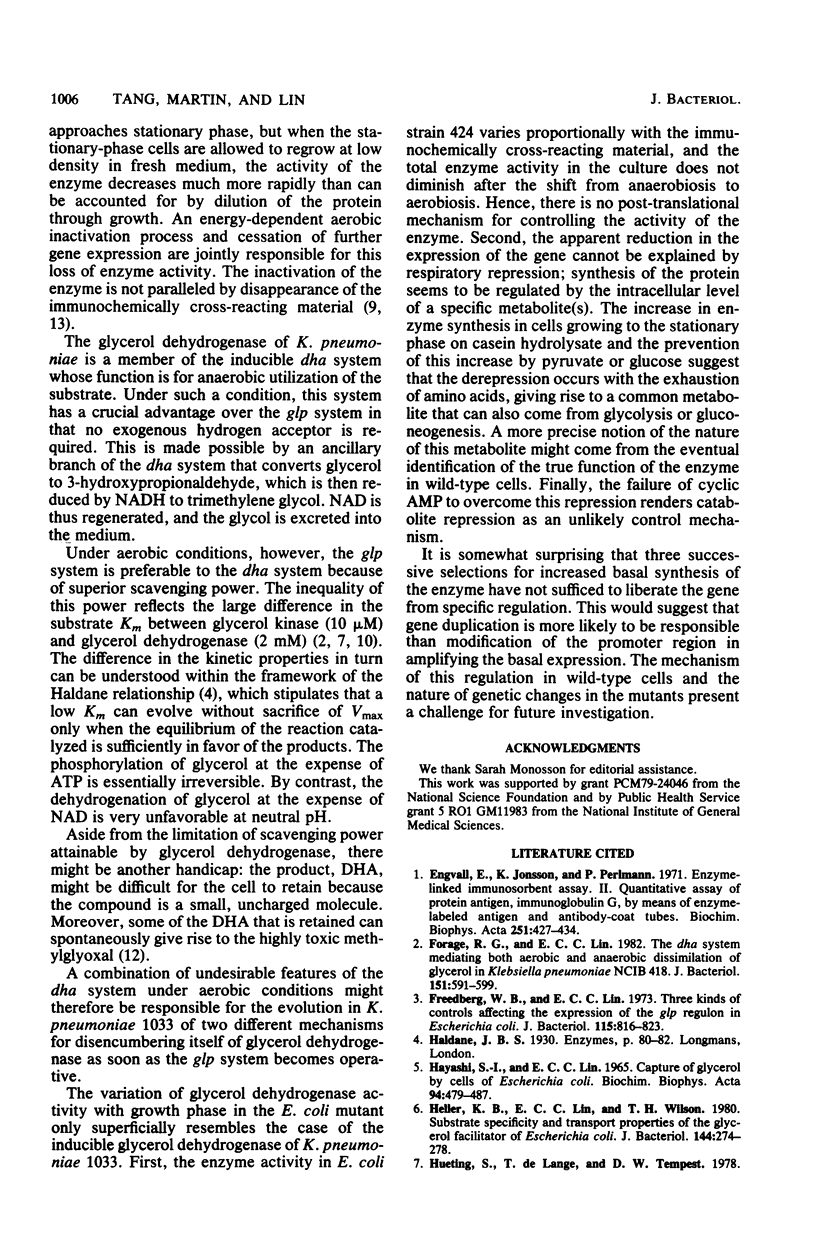Abstract
An Escherichia coli mutant using an NAD-linked dehydrogenase instead of an ATP-dependent kinase as the first enzyme for glycerol dissimilation excreted dihydroxyacetone during the initial phase of growth. The intermediate was salvaged as growth of the culture advanced. The transient loss of the intermediate into the medium appeared to be partly determined by variation of the level of glycerol dehydrogenase with growth conditions. With up to 2% casein hydrolysate as the carbon and energy source, the cellular level of the dehydrogenase increased 1 order of magnitude at the end of growth. This increase was probably caused by the depletion of certain metabolites and was prevented by the addition of pyruvate or glucose to the growth medium. The repressive effect of these compounds was not lifted by the addition of cyclic AMP. Diminution of oxygen tension in the culture medium with increased cell density was not directly responsible for the increase of the enzyme level. Thus, neither catabolite repression nor respiratory repression was implicated as an important control mechanism in the synthesis of this enzyme. Since increases in the specific activity of the enzyme in cell extracts reflected increases in the concentration of the enzyme protein, post-translational control was also not involved. A novel kind of regulation of gene expression is indicated.
Full text
PDF






Selected References
These references are in PubMed. This may not be the complete list of references from this article.
- Engvall E., Jonsson K., Perlmann P. Enzyme-linked immunosorbent assay. II. Quantitative assay of protein antigen, immunoglobulin G, by means of enzyme-labelled antigen and antibody-coated tubes. Biochim Biophys Acta. 1971 Dec 28;251(3):427–434. doi: 10.1016/0005-2795(71)90132-2. [DOI] [PubMed] [Google Scholar]
- Forage R. G., Lin E. C. DHA system mediating aerobic and anaerobic dissimilation of glycerol in Klebsiella pneumoniae NCIB 418. J Bacteriol. 1982 Aug;151(2):591–599. doi: 10.1128/jb.151.2.591-599.1982. [DOI] [PMC free article] [PubMed] [Google Scholar]
- Freedberg W. B., Lin E. C. Three kinds of controls affecting the expression of the glp regulon in Escherichia coli. J Bacteriol. 1973 Sep;115(3):816–823. doi: 10.1128/jb.115.3.816-823.1973. [DOI] [PMC free article] [PubMed] [Google Scholar]
- HAYASHI S., LIN E. C. CAPTURE OF GLYCEROL BY CELLS OF ESCHERICHIA COLI. Biochim Biophys Acta. 1965 Mar 29;94:479–487. doi: 10.1016/0926-6585(65)90056-7. [DOI] [PubMed] [Google Scholar]
- Heller K. B., Lin E. C., Wilson T. H. Substrate specificity and transport properties of the glycerol facilitator of Escherichia coli. J Bacteriol. 1980 Oct;144(1):274–278. doi: 10.1128/jb.144.1.274-278.1980. [DOI] [PMC free article] [PubMed] [Google Scholar]
- LIN E. C., LEVIN A. P., MAGASANIK B. The effect of aerobic metabolism on the inducible glycerol dehydrogenase of Aerobacter aerogenes. J Biol Chem. 1960 Jun;235:1824–1829. [PubMed] [Google Scholar]
- Lin E. C. Glycerol dissimilation and its regulation in bacteria. Annu Rev Microbiol. 1976;30:535–578. doi: 10.1146/annurev.mi.30.100176.002535. [DOI] [PubMed] [Google Scholar]
- Neijssel O. M., Hueting S., Crabbendam K. J., Tempest D. W. Dual pathways of glycerol assimilation in Klebsiella aerogenes NCIB418: their regulation and possible functional significance. Arch Microbiol. 1975 Jun 20;104(1):83–87. doi: 10.1007/BF00447304. [DOI] [PubMed] [Google Scholar]
- Richey D. P., Lin E. C. Importance of facilitated diffusion for effective utilization of glycerol by Escherichia coli. J Bacteriol. 1972 Nov;112(2):784–790. doi: 10.1128/jb.112.2.784-790.1972. [DOI] [PMC free article] [PubMed] [Google Scholar]
- Riddle V., Lorenz F. W. Nonenzymic, polyvalent anion-catalyzed formation of methylglyoxal as an explanation of its presence in physiological systems. J Biol Chem. 1968 May 25;243(10):2718–2724. [PubMed] [Google Scholar]
- Ruch F. E., Jr, Lin E. C., Kowit J. D., Tang C. T., Goldberg A. L. In vivo inactivation of glycerol dehydrogenase in Klebsiella aerogenes: properties of active and inactivated proteins. J Bacteriol. 1980 Mar;141(3):1077–1085. doi: 10.1128/jb.141.3.1077-1085.1980. [DOI] [PMC free article] [PubMed] [Google Scholar]
- St Martin E. J., Freedberg W. B., Lin E. C. Kinase replacement by a dehydrogenase for Escherichia coli glycerol utilization. J Bacteriol. 1977 Sep;131(3):1026–1028. doi: 10.1128/jb.131.3.1026-1028.1977. [DOI] [PMC free article] [PubMed] [Google Scholar]
- Tanaka S., Lerner S. A., Lin E. C. Replacement of a phosphoenolpyruvate-dependent phosphotransferase by a nicotinamide adenine dinucleotide-linked dehydrogenase for the utilization of mannitol. J Bacteriol. 1967 Feb;93(2):642–648. doi: 10.1128/jb.93.2.642-648.1967. [DOI] [PMC free article] [PubMed] [Google Scholar]
- Tang C. T., Ruch F. E., Jr, Lin C. C. Purification and properties of a nicotinamide adenine dinucleotide-linked dehydrogenase that serves an Escherichia coli mutant for glycerol catabolism. J Bacteriol. 1979 Oct;140(1):182–187. doi: 10.1128/jb.140.1.182-187.1979. [DOI] [PMC free article] [PubMed] [Google Scholar]


